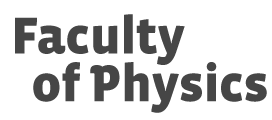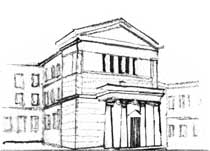Condensed Matter Physics Seminar
2006/2007 | 2007/2008 | 2008/2009 | 2009/2010 | 2010/2011 | 2011/2012 | 2012/2013 | 2013/2014 | 2014/2015 | 2015/2016 | 2016/2017 | 2017/2018 | 2018/2019 | 2019/2020 | 2020/2021 | 2021/2022 | 2022/2023 | 2023/2024 | 2024/2025
2024-03-15 (Friday)
Paweł Jakubczyk (IFT FUW)
Can Bose-Einstein condensation occur via a first order transition?
I will discuss two results concerning the mean-field phase diagram of Bose mixtures.
2024-03-08 (Friday)
Priyanka Mishra, Stanisław Świerczewski, Andrzej Frączak (FUW)
Students' talks
Priyanka Mishra
"Electronic and Phonon band structure of Silicon and Aluminum using first principles calculations",
Stanisław Świerczewski
"From the nonlinearity in the single-mode Kerr model to quantum reservoir computing",
Andrzej Frączak
”Vortices and spin dynamics in a polariton condensate”.
"Electronic and Phonon band structure of Silicon and Aluminum using first principles calculations",
Stanisław Świerczewski
"From the nonlinearity in the single-mode Kerr model to quantum reservoir computing",
Andrzej Frączak
”Vortices and spin dynamics in a polariton condensate”.
2024-01-26 (Friday)
Grzegorz Jaczewski, Mikołaj Walicki, Stanisław Kalinowski, Kamil Szychta (FUW)
Students' talks
On Friday 26th January at 12.15 we host students' talks:
Grzegorz Jaczewski (FUW)
"Bloch oscillations on Bethe lattice",
Mikołaj Walicki (FUW)
"Light matter coupling in (almost) flat bands",
Stanisław Kalinowski (FUW)
"Fracton phases of matter",
Kamil Szychta (FUW)
"Exploring Covalent Organic Frameworks (COFs) - design and emerging applications of advanced porous materials".
Grzegorz Jaczewski (FUW)
"Bloch oscillations on Bethe lattice",
Mikołaj Walicki (FUW)
"Light matter coupling in (almost) flat bands",
Stanisław Kalinowski (FUW)
"Fracton phases of matter",
Kamil Szychta (FUW)
"Exploring Covalent Organic Frameworks (COFs) - design and emerging applications of advanced porous materials".
2024-01-19 (Friday)
Jędrzej Wardyn (IFT FUW)
The dimerized frustrated ferromagnetic J1−J′1−J2 chain: valence bond solid states and unusual quantum phase transition
In this work, we investigate the low-energy properties of the dimerized frustrated ferromagnetic (FM) J1−J′1−J2 model with the density matrix renormalization group method. We show the ground state phase diagram spanned by a wide range of J'1/J1 and /J2|J1|features ferromagnetic phase and valence bond solid (VBS) phases that are continuations from the J'1/J1 limits of the model. In the limit J'1/J1=1 we recover FM J1-J2 model hosting $\mathcal{D}_3$-VBS state where valence bonds form between third-neighbor spins. The other VBS phase named mixed-VBS features both second- and third neighboring spins that continue from the J'1/J1=0 limit. We show that both phases feature hidden antiferromagnetic order and twofold degeneracy in the entanglement spectrum characterizing them as Haldane states. Remarkably, we encounter a nontrivial quantum phase transition between two topological VBS states, where at the boundary of phases VBS stability is enhanced.We discuss results in the context of other spin chain models and edge-sharing cuprate materials.
2024-01-12 (Friday)
Hiroyuki Yamase (NIMS Tsukuba, Japan)
Do antiferromagnetic fluctuations favor high-temperature superconductivity?
It is well known that antiferromagnetic fluctuations lead to unconventional superconductivity.In particular, they are believed to be a glue of high-temperature superconductivity in cupratesand iron pnictides. In this talk, in the framework of Eliashberg theory, I discuss thatthe spin-fluctuation mechanism suffers from the self-restraint effect of superconductivity in generaland is not favorable to realizing high-temperature superconductivity. I propose that the instantaneousspin interaction, instead of spin fluctuations, can be crucial to cuprate superconductors.I will also discuss briefly iron pnictides and other unconventional superconductorswith low critical temperatures.
2023-12-15 (Friday)
Artem Volosniev (IST Austria)
Spin-electric coupling in lead-halide perovskites
Lead halide perovskites enjoy a number of remarkable optoelectronic properties that interest both ‘blue skies researchers’ and applied scientists. While the former are trying to understand what makes this material special, the latter are working towards novel technologies, such as solar cells. In this talk, I will present a collaborative theoretical/experimental study that argued that the interaction of lead halide perovskites with electromagnetic fields is ‘special’ due to high polarizability of its constituents. To this end, we used symmetry considerations to introduce a phenomenological model Hamiltonian, and then benchmarked it against a measured angle of rotation in the Faraday effect.
2023-12-08 (Friday)
Johannes Knolle (TUM, Munich Germany)
Anomalous Quantum Oscillations in Metals and Insulators
Quantum oscillation phenomena describe the periodic variation of thermodynamic and transport properties of materials as a function of magnetic field. Since their discovery in 1930, their observation is commonly assumed to be a definite sign for the presence of a Fermi surface (FS) in a metal. Indeed, the effect forms the basis of a well-established experimental procedure for accurately measuring FS topology and geometry of metallic systems. In this talk I will discuss recent developments which challenge the canonical description of quantum oscillations. I will first review our work on quantumoscillations in insulators. Next, I will discuss the possibility of sharp quantum oscillation frequencies in metals which do not correspond to Fermi surface orbits and the effect of strong electron interactions. Finally, I will present experimental results confirming our theoretical predictions and discuss the broader implications of anomalous quantum oscillations.
2023-12-01 (Friday)
Vera Uzunova (IFT FUW)
Nonlinear spin dynamics of ferromagnetic ring in the vortex state and its application for spin-transfer nano-oscillator
We study a nonlinear spin dynamics of a ferromagnetic ring in a vortex state induced by the spin-polarized current. The spin dynamics of ferromagnets is commonly believed to be gyroscopic but we show that a response of the vortex-state ring to the spin-polarized current has hysteretic behaviour. We also found that the nonlinear spin oscillations are described by the simple and universal equation, known for many physical problems, like a point Josephson contact. We also suggest a design of a spin-transfer nano-oscillator (STNO) using the ferromagnetic ring as a free layer. Proposed nano-oscillator is characterised by the working frequencies up to 10 GHz, that makes it advantageous over the disc-based vortex oscillators operating in the sub-GHz range. Although the averaged output electromotive force vanishes, the output signal can be extracted with the help of special inhomogeneous analysers.
2023-11-24 (Friday)
Piotr Magierski (Warsaw University of Technology & University of Washington)
Exotic features of superfluidity far from equilibrium
Superfluidity is a generic feature of various quantum systems at low temperatures. It has been experimentally confirmed in many condensed matter systems, in He-3 and He-4 liquids, in nuclear systems, including nuclei and neutron stars, in both fermionic and bosonic cold atoms in traps, and it is also predicted to show up in dense quark matter. The time-dependent density functional theory (TDDFT) is, to date, the only microscopic method that allow to investigate fermionic superfluidity far from equilibrium. The local version of TDDFT is particularly well suited for leadership-class computersof hybrid (CPU+GPU) architecture. Using the most powerful supercomputers, we are currently able to study a real-time 3D dynamics without any symmetry restrictions evolving up to hundreds of thousands of superfluid fermions. It represents a true qualitative leap in quantum simulations of superfluid systems, allowing us to make quantitative predictions and reach limits inaccessible in laboratories. During the talk I will review several applications and results concerning nuclear collisions and induced fission, dynamics of nuclear matter in neutron stars, dynamics of topological excitations and exotic structures in ultracold atomic clouds.
2023-11-17 (Friday)
Markus Heyl (University of Augsburg)
Active quantum flocks
Flocks of animals represent a fascinating archetype of collective behavior in the macroscopic classical world, where the constituents, such as birds, concertedly perform motions and actions as if being one single entity. Here, we address the outstanding question of whether flocks can also form in the microscopic world at the quantum level. For that purpose, we introduce the concept of active quantum matter by formulating a class of models of active quantum particles on a one-dimensional lattice. We provide both analytical and large-scale numerical evidence that these systems can give rise to quantum flocks. A key finding is that these flocks, unlike classical ones, exhibit distinct quantum properties by developing strong quantum coherence over long distances. We propose that quantum flocks could be experimentally observed in Rydberg atom arrays. Our work paves the way towards realizing the intriguing collective behaviors of biological active particles in quantum matter systems. We expect that this opens up a path towards a yet totally unexplored class of nonequilibrium quantum many-body systems with unique properties.The seminar will be held as a part of the Distinguished Lectures on Complex Systems and Quantum Physics series.







